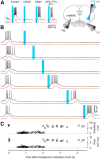Synaptic Depression Influences Inspiratory-Expiratory Phase Transition in Dbx1 Interneurons of the preBötzinger Complex in Neonatal Mice
- PMID: 26290237
- PMCID: PMC4540798
- DOI: 10.1523/JNEUROSCI.0351-15.2015
Synaptic Depression Influences Inspiratory-Expiratory Phase Transition in Dbx1 Interneurons of the preBötzinger Complex in Neonatal Mice
Abstract
The brainstem preBötzinger complex (preBötC) generates the rhythm underlying inspiratory breathing movements and its core interneurons are derived from Dbx1-expressing precursors. Recurrent synaptic excitation is required to initiate inspiratory bursts, but whether excitatory synaptic mechanisms also contribute to inspiratory-expiratory phase transition is unknown. Here, we examined the role of short-term synaptic depression using a rhythmically active neonatal mouse brainstem slice preparation. We show that afferent axonal projections to Dbx1 preBötC neurons undergo activity-dependent depression and we identify a refractory period (∼2 s) after endogenous inspiratory bursts that precludes light-evoked bursts in channelrhodopsin-expressing Dbx1 preBötC neurons. We demonstrate that the duration of the refractory period-but neither the cycle period nor the magnitude of endogenous inspiratory bursts-is sensitive to changes in extracellular Ca(2+). Further, we show that postsynaptic factors are unlikely to explain the refractory period or its modulation by Ca(2+). Our findings are consistent with the hypothesis that short-term synaptic depression in Dbx1 preBötC neurons influences the inspiratory-expiratory phase transition during respiratory rhythmogenesis.
Significance statement: Theories of breathing's neural origins have heretofore focused on intrinsically bursting "pacemaker" cells operating in conjunction with synaptic inhibition for phase transition and cycle timing. However, contemporary studies falsify an obligatory role for pacemaker-like neurons and synaptic inhibition, giving credence to burst-generating mechanisms based on recurrent excitation among glutamatergic interneurons of the respiratory kernel. Here, we investigated the role of short-term synaptic depression in inspiratory-expiratory phase transition. Until now, this role remained an untested prediction of mathematical models. The present data emphasize that synaptic properties of excitatory interneurons of the respiratory rhythmogenic kernel, derived from Dbx1-expressing precursors, may provide the core logic underlying the rhythm for breathing.
Keywords: breathing; central pattern generator; oscillation; respiration.
Copyright © 2015 the authors 0270-6474/15/3511606-06$15.00/0.
Figures




Similar articles
-
Defining preBötzinger Complex Rhythm- and Pattern-Generating Neural Microcircuits In Vivo.Neuron. 2016 Aug 3;91(3):602-14. doi: 10.1016/j.neuron.2016.07.003. Neuron. 2016. PMID: 27497222 Free PMC article.
-
Inhibitory Subpopulations in preBötzinger Complex Play Distinct Roles in Modulating Inspiratory Rhythm and Pattern.J Neurosci. 2024 Jun 19;44(25):e1928232024. doi: 10.1523/JNEUROSCI.1928-23.2024. J Neurosci. 2024. PMID: 38729762 Free PMC article.
-
Dbx1 Pre-Bötzinger Complex Interneurons Comprise the Core Inspiratory Oscillator for Breathing in Unanesthetized Adult Mice.eNeuro. 2018 May 28;5(3):ENEURO.0130-18.2018. doi: 10.1523/ENEURO.0130-18.2018. eCollection 2018 May-Jun. eNeuro. 2018. PMID: 29845107 Free PMC article.
-
PreBötzinger complex and pacemaker neurons: hypothesized site and kernel for respiratory rhythm generation.Annu Rev Physiol. 1998;60:385-405. doi: 10.1146/annurev.physiol.60.1.385. Annu Rev Physiol. 1998. PMID: 9558470 Review.
-
Neuronal mechanisms of respiratory rhythm generation: an approach using in vitro preparation.Jpn J Physiol. 1997 Oct;47(5):385-403. doi: 10.2170/jjphysiol.47.385. Jpn J Physiol. 1997. PMID: 9504127 Review.
Cited by
-
Interdependence of cellular and network properties in respiratory rhythmogenesis.bioRxiv [Preprint]. 2023 Nov 2:2023.10.30.564834. doi: 10.1101/2023.10.30.564834. bioRxiv. 2023. Update in: Proc Natl Acad Sci U S A. 2024 May 7;121(19):e2318757121. doi: 10.1073/pnas.2318757121. PMID: 37961254 Free PMC article. Updated. Preprint.
-
Inspiratory Off-Switch Mediated by Optogenetic Activation of Inhibitory Neurons in the preBötzinger Complex In Vivo.Int J Mol Sci. 2021 Feb 18;22(4):2019. doi: 10.3390/ijms22042019. Int J Mol Sci. 2021. PMID: 33670653 Free PMC article.
-
Fate mapping neurons and glia derived from Dbx1-expressing progenitors in mouse preBötzinger complex.Physiol Rep. 2017 Jun;5(11):e13300. doi: 10.14814/phy2.13300. Physiol Rep. 2017. PMID: 28611151 Free PMC article.
-
Breathing Rhythm and Pattern and Their Influence on Emotion.Annu Rev Neurosci. 2022 Jul 8;45:223-247. doi: 10.1146/annurev-neuro-090121-014424. Epub 2022 Mar 8. Annu Rev Neurosci. 2022. PMID: 35259917 Free PMC article. Review.
-
Inspiratory and sigh breathing rhythms depend on distinct cellular signalling mechanisms in the preBötzinger complex.J Physiol. 2024 Mar;602(5):809-834. doi: 10.1113/JP285582. Epub 2024 Feb 14. J Physiol. 2024. PMID: 38353596 Free PMC article.
References
-
- Bianchi AL, Denavit-Saubié M, Champagnat J. Central control of breathing in mammals: neuronal circuitry, membrane properties, and neurotransmitters. Physiol Rev. 1995;75:1–45. - PubMed
Publication types
MeSH terms
Substances
Grants and funding
LinkOut - more resources
Full Text Sources
Molecular Biology Databases
Miscellaneous
